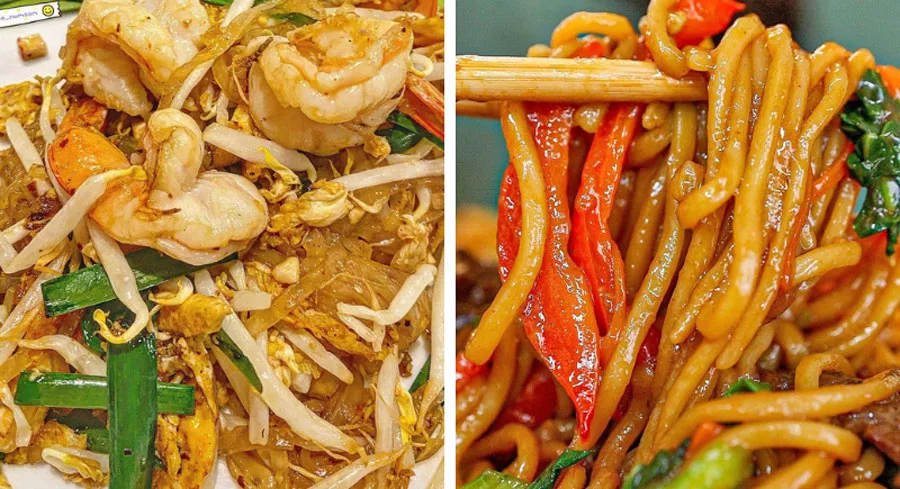For those of you who like Asian cuisine, you may be familiar with Pad Thai and Lo Mein dishes. Both come from Asia, where Pad Thai is a Thai dish and Lo Mein comes from China, both are very popular and are in the spotlight in the Asian culinary world. For those of you who like cooking, of course you want to know which is the healthiest, Pad Thai vs Lo Mein.
Pad Thai and Lo Mein use different ingredients even though they appear to be the same at first glance. Thai food, Pad Thai is made from rice noodles, tofu, peanuts, eggs, and tamarind sauce.
Meanwhile Lo Mein is a Chinese food made from eggs, and topped with vegetables, savory sauce and meat. Recently, Asian culinary delights have become the focus of many circles, not only because they taste delicious but because they can provide health benefits.
Now, in modern times, people have started to pay attention to the ingredients of a food and its health benefits. So, it’s not just the taste, but it’s important to pay attention to nutritional and health aspects.
Pad Thai vs Lo Mein
In this post, we will explore one by one between Pad Thai vs Lo Mein, starting from the ingredients, nutritional content, and benefits for human welfare.
What is Pad Thai?
Pad Thai is a popular food from Thailand, this food represents a country with a quite unique culinary model, Thailand is not only successful in its agricultural world but is famous as a country with the most unique, exotic and many culinary delights that are liked by foreign countries and one of the very popular ones is Pad Thai.
Pad Thai is a culinary dish made with ingredients such as vermicelli, eggs, tofu, bean sprouts, garlic, shallots, and protein sources such as shrimp, tofu and chicken. This Thai food is served with sweet and tangy tamarind sauce, sprinkled or topped with crushed peanuts and lime juice. The original Pad Thai recipe has always been maintained, but now there are many combination recipes for Pad Thai by adding various vegetables, spices and adjusting to individual tastes.
The taste is very good, the combination of sweet, sour and savory flavors is right and harmonious and this is what makes this Thai dish famous abroad. In fact, fans of Thai food will definitely know Pad Thai.
That’s a glimpse of the meaning of the Pad Thai dish, now let’s compare it with Lo Mein so that we understand how the comparison between Pad Thai vs Lo Mein will be and this is the aim of this article.
What is Lo Mein?
The famous Chinese food Lo Mein is a highlight in various Asian restaurants. The origin of this food is Canton, China. Lomein is made with egg noodles, after it is cooked soft, it is sprinkled with vegetables, meat and seafood so that the taste is even more appetizing.
This Chinese dish is famous not only for its taste, but also for its versatility, where in this dish it is possible to combine various ingredients according to taste.
That’s why the taste of Lo Mein sometimes varies because it really depends on the ingredients used. However, in general, the ingredients used in Lo mein include savory, sweet and umami flavors. Apart from that, there are common additions, these are oyster sauce, soy sauce, ginger, garlic, and a little sesame oil to improve the overall taste.
These ingredients will produce a Lo Mein dish that is delicious, flavorful, satisfying and showcases the art of Chinese food preparation.
What are the key ingredients of pad Thai and lo mein?
By knowing the main ingredients, we can clearly understand the difference between Pad Thai vs Lo Mein.
Pad Thai
The main ingredients in making Pad Thai are:
- Rice Noodles: Flat and wide rice noodles,
- Protein: Generally use shrimp, chicken, or tofu.
- Eggs: Beaten eggs stir-fried with noodles and several other ingredients
- Bean sprouts: Crispy bean sprouts add texture and freshness to pad thai.
- Tamarind sauce: This is a tangy sauce made from tamarind, and it is the original value of pad Thai cooking.
- Peanuts: Peanuts that have been crushed as a topping or sprinkle on top.
- Lime: Squeeze lime on top to add freshness and uniqueness
- Thai chili peppers (optional): This is just to add spiciness, great to add if you like spicy food.
Lo Mein
The main ingredients in making Pad Thai include:
- Egg noodles: This is the main element in Lo Mein dishes to add chewiness.
- Vegetables: Generally use vegetables such as bell peppers, carrots, broccoli, bok choy and mushrooms.
- Protein: Beef, chicken, shrimp, tofu, and pork.
- Soy sauce: This is a savory sauce to add flavor and dark color to Lo Mein dishes.
- Ginger and garlic: These aromatic ingredients enhance delicious flavors, and add delicious flavor to dishes.
- Sesame Oil: Adding a little sesame oil can enhance the fragrant and spicy taste of the Lo mein dish.
- Scallions: Sliced spring onions are used for garnish, and add freshness and color.
Which is Healthy, Pad Thai or Lo Mein?
After looking at the ingredients for each dish, maybe now you know which food is the healthiest between the two (Pad Thai Vs Lo Mein).
However, to be clearer, we feel the need to carry out a nutritional analysis, we need to evaluate the micronutrients and macronitrients as well as the cooking method. Ok, let’s look more clearly at the nutritional facts of Pad Thai and Lo mein, we have shown them in table form so it is easy to pay attention and determine which is the healthiest between these two Asian dishes.
| Nutrients | Pad Thai (per serving) | Lo Mein (per serving) |
| Calories | 450-550 | 400-500 |
| Total Fat (g) | 15-25 | 10-15 |
| Saturated Fat (g) | 2-5 | 2-4 |
| Cholesterol (mg) | 50-100 | 30-60 |
| Carbohydrates (g) | 60-80 | 50-70 |
| Fiber (g) | 2-4 | 3-5 |
| Protein (g) | 10-15 | 12-18 |
| Sodium (mg) | 800-1200 | 800-1000 |
| Vitamin C (mg) | 10-20 | 8-15 |
| Vitamin A (IU) | 500-1000 | 400-800 |
| Calcium (mg) | 50-100 | 40-80 |
| Iron (mg) | 2-4 | 2-5 |
Note: This nutritional value is influenced by size, ingredients and cooking method including how long you cook it.
What are the Differences between Pad Thai Vs Lo Mein?
To make it easier to see the basic differences between these two Asian cuisines, we have created the following table of differences:
| Aspect | Pad Thai | Lo Mein |
| Cuisine origin | Thai | Chinese |
| Noodle type | Rice noodles | Egg noodles |
| Flavor profile | Sweet, tangy, savory | Savory, umami |
| Protein options | Shrimp, chicken, tofu | Chicken, beef, pork, shrimp, tofu |
| Sauce | Tamarind-based | Soy sauce-based |
| Key ingredients | Tamarind sauce, peanuts, bean sprouts | Soy sauce, vegetables, protein |
| Cooking method | Stir-fried | Stir-fried |
| Garnish | Crushed peanuts, lime | Scallions, sesame oil |
| Spiciness | Can be mild or spicy | Generally not spicy |
| Cultural significance | Iconic Thai dish | Popular Chinese dish |
| Regional variations | Various adaptations | Various adaptations |
Indeed, Pad Thai and Lo Mein are both delicious foods, but they are different in terms of culinary origin (cuisine from different countries), type of noodle, taste profile, and main ingredients used as well as the cultural significance of each region.
Thai tends to have a sweet, savory, tangy taste, using tamarind and peanuts as prominent ingredients. Meanwhile Lo Mein comes with a savory and umami taste that comes from soy sauce, and the various vegetables used as well as the protein source.
Check out more:
– Is Shrimp Meat? Why?
– Chicken Samosas Cheesecake Factory Recipe
From its origin, Pad Thai is a Thai food that is quite well known abroad. Meanwhile, Lo Mein is a Chinese dish which is also very popular. Both are considered versatile and can be adjusted with other ingredients according to individual tastes.
What Are the Similarities Between Pad Thai and Lo Mein?
Pad Thai and Lo Mein, both are typical Asian foods, but despite the many differences between the two, there are still some similarities. Let’s explore some of the similarities that exist between Pad Thai and Lo Mein.
- Noodle-based dishes: Both Lo mein and pad Thai are noodle-based dishes. This is truly a satisfying meal.
- Versatile: In terms of the ingredients used, both are classified as multipurpose foods, you can add other ingredients to adjust the food to your taste.
- The same in frying: The way to cook Pad Thai and Lo Mein is by frying, both are done in the same way, where the noodles and other ingredients are cooked in a preheated pan.
- Balance of flavors: Another similarity is a balanced taste. Indeed, both have different tastes, but they both have a balance of sweet, savory and umami flavors. Lo Mein and Pad Thai often add ingredients that create a savory taste such as garlic, soy sauce and other spices.
- Popular Asian dishes: These two dishes are known as typical foods of each country; China and Thailand. Its popularity continues to grow and is often introduced in popular restaurants around the world.
How to Store: Pad Thai Vs Lo Mein
Here are some tips to think about when storing Chinese and Thai dishes.
The way to store both is relatively the same, because both are made with almost the same ingredients, and even the cooking method is the same. So technically the method for storing Pad Thai VS Lo Mein is also the same. Here are important things you should know about storing both for future use.
- Let the dish cool: When you want to store it, let it sit at room temperature until it cools to room temperature to prevent condensation in storage.
- After cooling to room temperature, or about 2 hours after cooking, put both (Lo Mein and PadbThai) in an airtight container or plastic sealing, store in the refrigerator for 3-4 days.
- Freezing: If you want to extend the shelf life of both, you can choose the freezing technique. The method for freezing pad Thai and lo mein is the same as freezing Factor Meals, Rice Krispie Treats, Velveeta Cheese, etc. Make sure the container is tightly closed. Freezing Pad Thai and Lo Mein makes them last up to 1 month.
How To Reheat Loe Mein and Pad Thai
Microwave: Place the food in a microwave-safe plate, cover and heat for 30 seconds, if necessary, stir until completely hot.
The next heating method is to use a stove. Heat a frying pan on the stove over medium heat, add oil as needed in the pan, and add the noodles that have been cooled in the refrigerator, stir-fry for a few minutes until thoroughly cooked.
Note: Check the internal temperature of the food to ensure that the heated noodles are safe to eat. Make sure the internal temperature is 165 F or 74 C.

